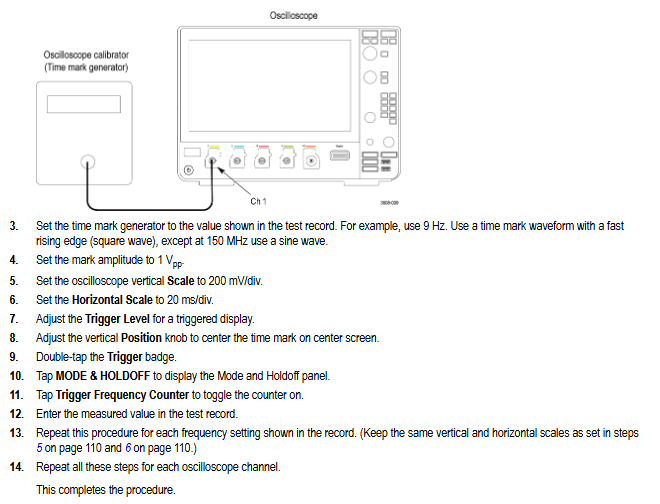TEKTRONIX 3 Series Mixed Domain Oscilloscope MDO32 and MDO34
Multi channel testing: After testing each channel (such as D0), set its Display to Off and activate the next channel (such as D1) to avoid interference between channels.
Question 3: How to test the display average noise level (DANL) in the spectrum analyzer function of the 3 series MDO? What are the DANL qualification standards for different frequency ranges?
Answer:
1、 DANL testing steps (no input signal, only 50 Ω terminal required)
Equipment connection: oscilloscope RF input connected to 50 Ω feedthrough terminal, no external signal input;
Oscilloscope settings:
Reset according to Default Setup;
Activate RF channel (RF button → On);
Set Trace mode: RF menu → Traces → Average=On, Normal=Off;
Detection mode: Detection Method → Manual → Average;
Reference level: Vertical Settings → Ref Level=-15dBm;
Frequency range setting and measurement:
9kHz-50kHz: Orizontal → Start=9kHz, Stop=50kHz, move the Marker (Multipurpose knob a) to the highest noise point, and record the DANL value;
50kHz-5MHz:Start=50kHz,Stop=5MHz,Center=2.525MHz, Record the highest noise level;
5MHz-2GHz (3-SA3 option): Start=5MHz, Stop=2GHz, Center=1GHz, Span=10MHz, record the highest noise value;
2GHz-3GHz (3-SA3 option): Start=2GHz, Stop=3GHz, Center=2.5GHz, Span=10MHz, record the highest noise value;
Data processing: Ignore stray signals above the noise level (refer to the "residual response" specification) and only record the noise baseline value.
2、 DANL qualification standards for different frequency ranges
Frequency range standard (without 3-SA3) 3-SA3 option typical values (better than standard)
9kHz-50kHz ≤-109dBm/Hz ≤-109dBm/Hz ≤-113dBm/Hz
50kHz-5MHz ≤-126dBm/Hz ≤-126dBm/Hz ≤-130dBm/Hz
5MHz-1GHz ≤-136dBm/Hz ≤-136dBm/Hz ≤-140dBm/Hz
1GHz-2GHz - ≤-136dBm/Hz ≤-140dBm/Hz
2GHz-3GHz - ≤-126dBm/Hz ≤-130dBm/Hz
3、 Testing precautions
Terminal matching: A 50 Ω terminal must be used, otherwise impedance mismatch may cause high noise measurement;
Stray elimination: If there is significantly higher than the base noise at a certain frequency point (such as 1.25GHz, 2.5GHz), the noise values on both sides of the noise should be recorded, rather than the noise itself;
Average time: In the low-frequency range (such as 9kHz-50kHz), wait for 60 seconds to ensure that the average trace is stable before reading.

- EMERSON
- Honeywell
- CTI
- Rolls-Royce
- General Electric
- Woodward
- Yaskawa
- xYCOM
- Motorola
- Siemens
- Rockwell
- ABB
- B&R
- HIMA
- Construction site
- electricity
- Automobile market
- PLC
- DCS
- Motor drivers
- VSD
- Implications
- cement
- CO2
- CEM
- methane
- Artificial intelligence
- Titanic
- Solar energy
- Hydrogen fuel cell
- Hydrogen and fuel cells
- Hydrogen and oxygen fuel cells
- tyre
- Chemical fiber
- dynamo
- corpuscle
- Pulp and paper
- printing
- fossil
- FANUC
- Food and beverage
- Life science
- Sewage treatment
- Personal care
- electricity
- boats
- infrastructure
- Automobile industry
- metallurgy
- Nuclear power generation
- Geothermal power generation
- Water and wastewater
- Infrastructure construction
- Mine hazard
- steel
- papermaking
- Natural gas industry
- Infrastructure construction
- Power and energy
- Rubber and plastic
- Renewable energy
- pharmacy
- mining
- Plastic industry
- Schneider
- Kongsberg
- NI
- Wind energy
- International petroleum
- International new energy network
- gas
- WATLOW
- ProSoft
- SEW
- wind
- ADVANCED
- Reliance
- YOKOGAWA
- TRICONEX
- FOXBORO
- METSO
- MAN
- Advantest
- ADVANCED
- ALSTOM
- Control Wave
- AB
- AMAT
- STUDER
- KONGSBERG
- MOTOROLA
- DANAHER MOTION
- Bently
- Galil
- EATON
- MOLEX
- Triconex
- DEIF
- B&W
- ZYGO
- Aerotech
- DANFOSS
- KOLLMORGEN
- Beijer
- Endress+Hauser
- MOOG
- KB
- Moxa
- Rexroth
- YAMAHA
- Johnson
- Westinghouse
- WAGO
- TOSHIBA
- TEKTRONIX


Email:wang@kongjiangauto.com

























































































































